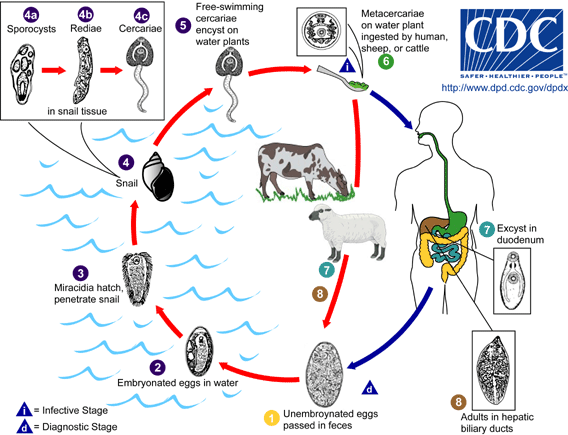Fascioliasis is caused by Fasciola hepatica and less often by F. gigantica, which are flat worms classified as liver flukes (trematodes). Some human cases have been caused by hybrid species. Additional Fasciola species have been found in animals.
As shown below, Fasciola parasites develop into adult flukes in the bile ducts of infected mammals, which pass immature Fasciola eggs in their feces. The next part of the life cycle occurs in freshwater. After several weeks, the eggs hatch, producing a parasite form known as the miracidium, which then infects a snail host. Under optimal conditions, the development process in the snail may be completed in 5 to 7 weeks; cercariae are then shed in the water around the snail. The cercariae lose their tails when they encyst as metacercariae (infective larvae) on water plants. In contrast to cercariae, metacercariae have a hard outer cyst wall and can survive for prolonged periods in wet environments.

Immature Fasciola eggs are discharged in the biliary ducts and in the stool. Eggs become embryonated in water, eggs release miracidiawhich invade a suitable snail intermediate host, including the genera Galba, Fossaria and Pseudosuccinea. In the snail the parasites undergo several developmental stages (sporocysts). The cercariae are released from the snail and encyst as metacercariae on aquatic vegetation or other surfaces. Mammals acquire the infection by eating vegetation containing metacercariae. Humans can become infected by ingesting metacercariae-containing freshwater plants, especially watercress. After ingestion, the metacercariae excyst in the duodenum and migrate through the intestinal wall, the peritoneal cavity, and the liver parenchyma into the biliary ducts, where they develop into adult flukes.
In humans, maturation from metacercariae into adult flukes takes approximately 3 to 4 months. The adult flukes (Fasciola hepatica: up to 30 mm by 13 mm; F. gigantica: up to 75 mm) reside in the large biliary ducts of the mammalian host. Fasciola hepatica infect various animal species, mostly herbivores (plant-eating animals).
Life cycle image and information courtesy of DPDx.
For more information view the source:Center for Disease Control
Recommended Test:Full GI Panel
Recommended Product:Freedom Cleanse Restore Parasite Cleanse